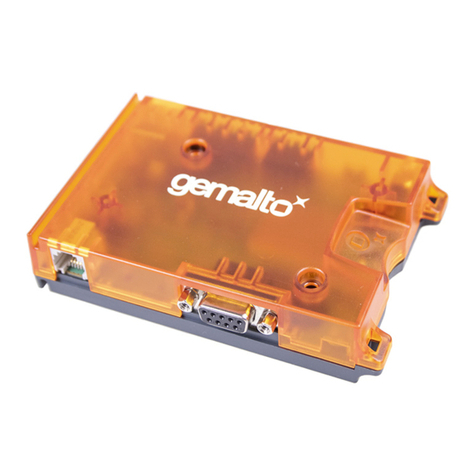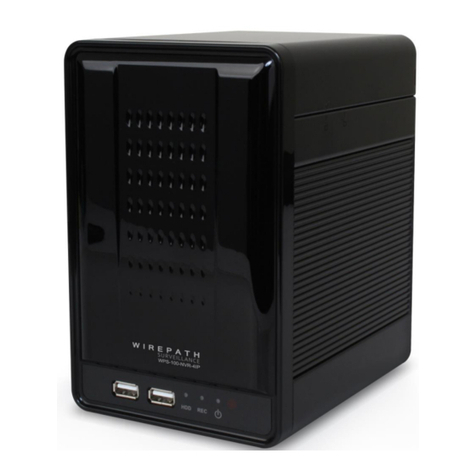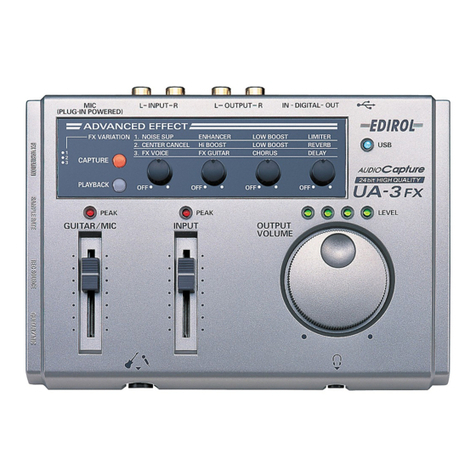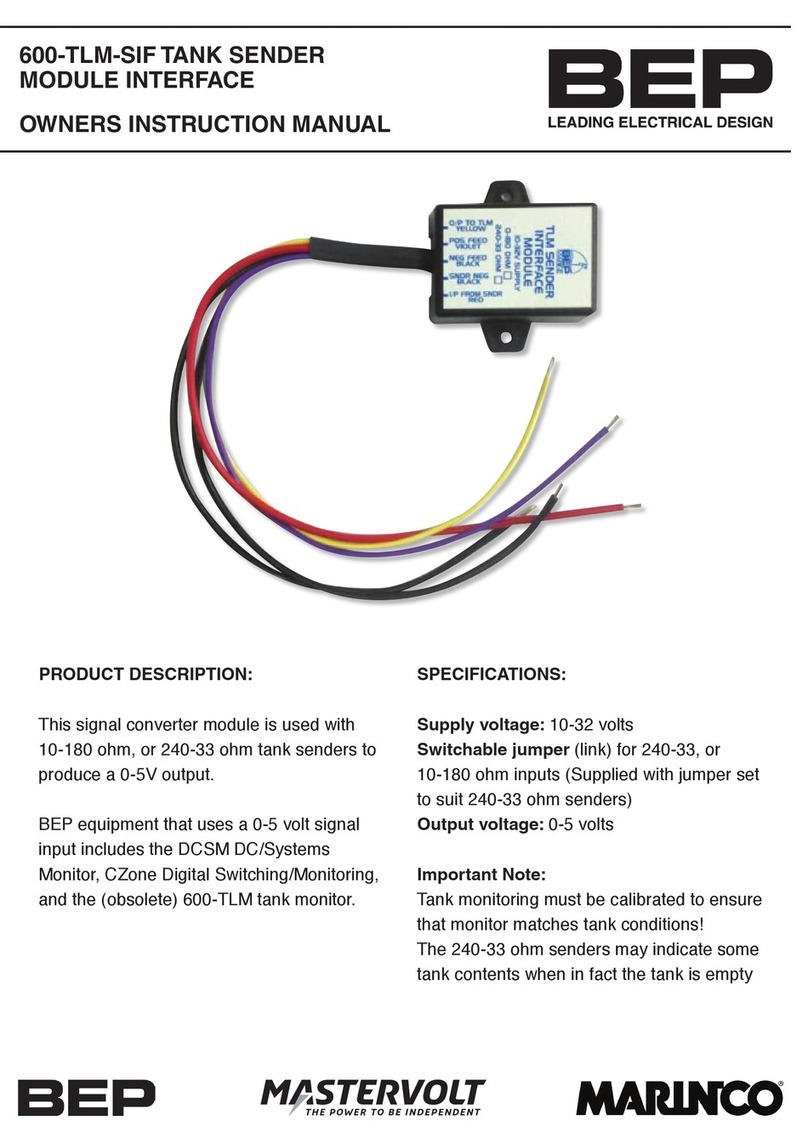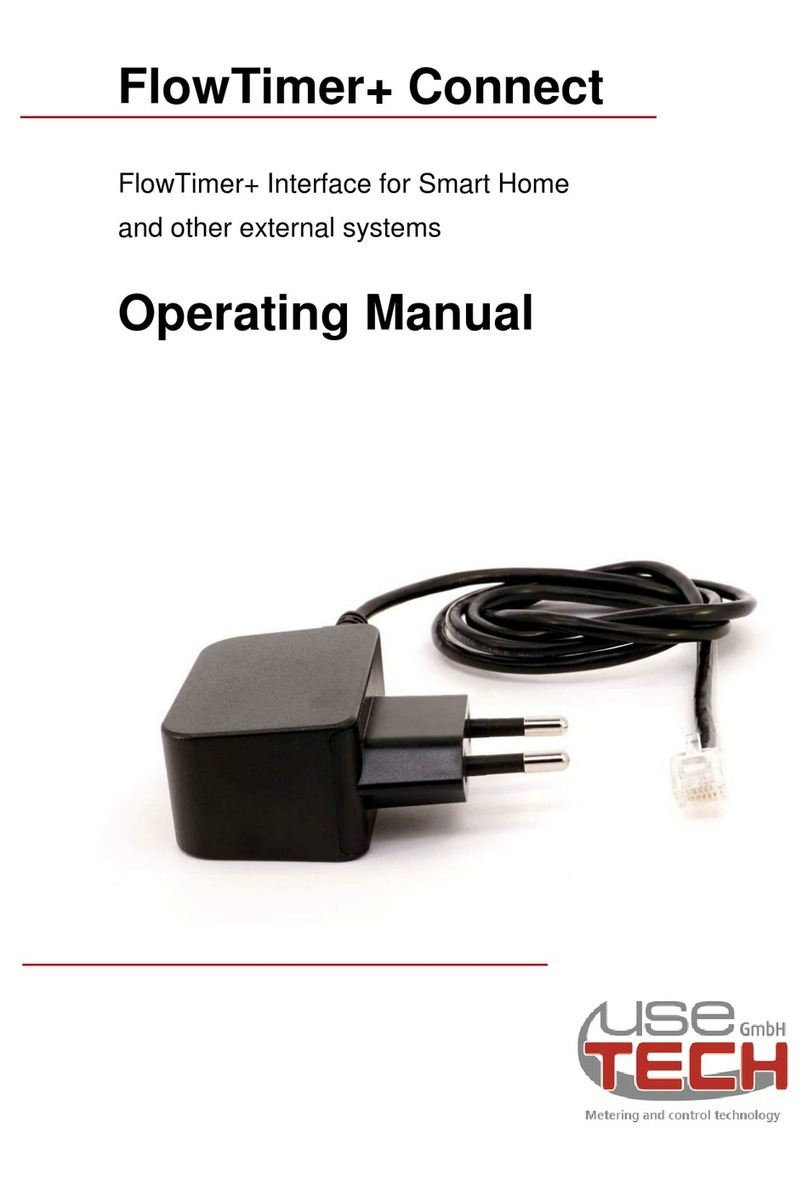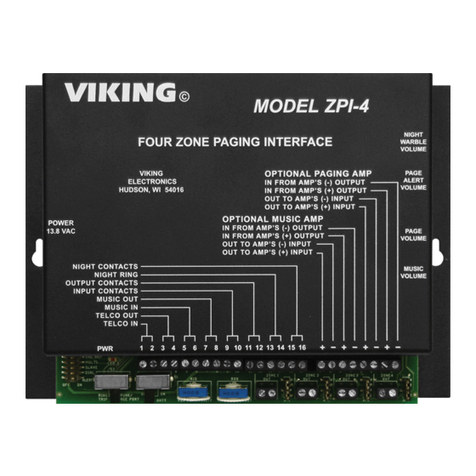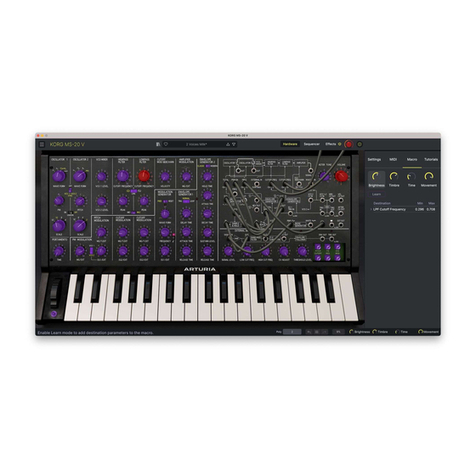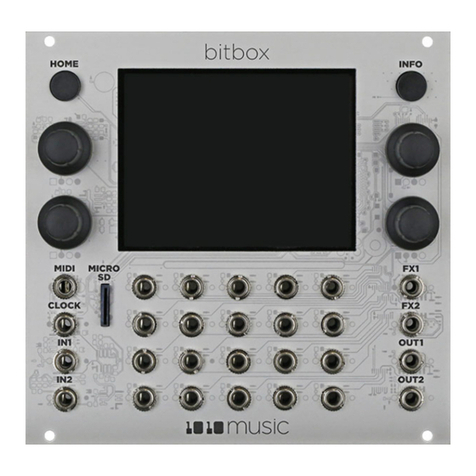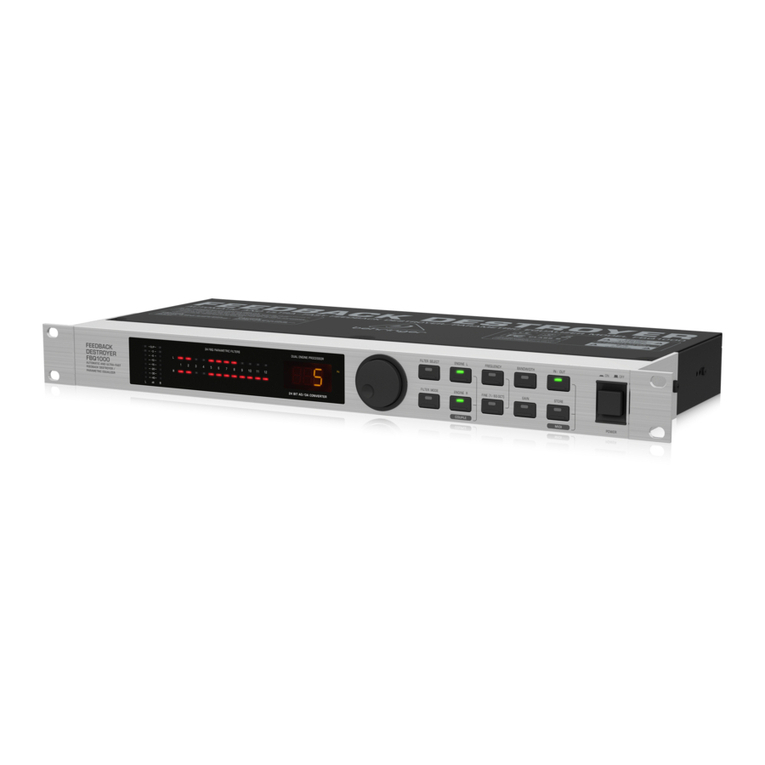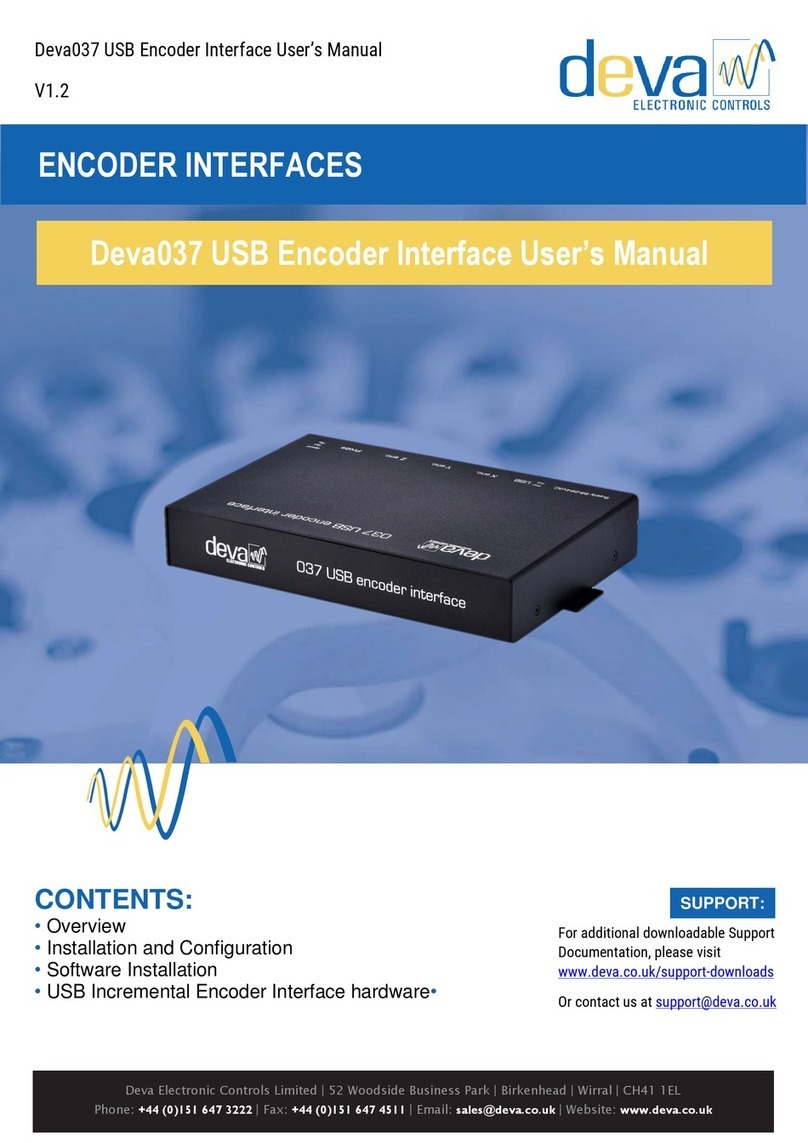Gemalto Cinterion ELS31-VA Operating and installation instructions

M2M.GEMALTO.COM
Cinterion®ELS31-VA/ELS51-VA
Hardware Interface Description
Version: 01.000
DocId: ELS31-VA_ELS51-VA_HID_v01.000

GENERAL NOTE
THE USE OF THE PRODUCT INCLUDING THE SOFTWARE AND DOCUMENTATION (THE "PROD-
UCT") IS SUBJECT TO THE RELEASE NOTE PROVIDED TOGETHER WITH PRODUCT. IN ANY
EVENT THE PROVISIONS OF THE RELEASE NOTE SHALL PREVAIL. THIS DOCUMENT CONTAINS
INFORMATION ON GEMALTO M2M PRODUCTS. THE SPECIFICATIONS IN THIS DOCUMENT ARE
SUBJECT TO CHANGE AT GEMALTO M2M'S DISCRETION. GEMALTO M2M GMBH GRANTS A NON-
EXCLUSIVE RIGHT TO USE THE PRODUCT. THE RECIPIENT SHALL NOT TRANSFER, COPY,
MODIFY, TRANSLATE, REVERSE ENGINEER, CREATE DERIVATIVE WORKS; DISASSEMBLE OR
DECOMPILE THE PRODUCT OR OTHERWISE USE THE PRODUCT EXCEPT AS SPECIFICALLY
AUTHORIZED. THE PRODUCT AND THIS DOCUMENT ARE PROVIDED ON AN "AS IS" BASIS ONLY
AND MAY CONTAIN DEFICIENCIES OR INADEQUACIES. TO THE MAXIMUM EXTENT PERMITTED
BY APPLICABLE LAW, GEMALTO M2M GMBH DISCLAIMS ALL WARRANTIES AND LIABILITIES.
THE RECIPIENT UNDERTAKES FOR AN UNLIMITED PERIOD OF TIME TO OBSERVE SECRECY
REGARDING ANY INFORMATION AND DATA PROVIDED TO HIM IN THE CONTEXT OF THE DELIV-
ERY OF THE PRODUCT. THIS GENERAL NOTE SHALL BE GOVERNED AND CONSTRUED
ACCORDING TO GERMAN LAW.
Copyright
Transmittal, reproduction, dissemination and/or editing of this document as well as utilization of its con-
tents and communication thereof to others without express authorization are prohibited. Offenders will be
held liable for payment of damages. All rights created by patent grant or registration of a utility model or
design patent are reserved.
Copyright © 2017, Gemalto M2M GmbH, a Gemalto Company
Trademark Notice
Gemalto, the Gemalto logo, are trademarks and service marks of Gemalto and are registered in certain
countries. Microsoft and Windows are either registered trademarks or trademarks of Microsoft Corpora-
tion in the United States and/or other countries. All other registered trademarks or trademarks mentioned
in this document are property of their respective owners.
ELS31-VA_ELS51-VA_HID_v01.000 2017-01-04
Confidential / Preliminary
Cinterion®ELS31-VA/ELS51-VA Hardware Interface Description
2
Page 2 of 106
Document Name: Cinterion®ELS31-VA/ELS51-VAHardware Interface Description
Version: 01.000
Date: 2017-01-04
DocId: ELS31-VA_ELS51-VA_HID_v01.000
Status: Confidential / Preliminary

Cinterion®ELS31-VA/ELS51-VA Hardware Interface Description
Contents
106
ELS31-VA_ELS51-VA_HID_v01.000 2017-01-04
Confidential / Preliminary
Page 3 of 106
Contents
1 Introduction.................................................................................................................9
1.1 Key Features at a Glance .................................................................................. 9
1.2 ELS31-VA/ELS51-VA System Overview ......................................................... 12
1.3 Circuit Concept ................................................................................................ 13
2 Interface Characteristics..........................................................................................14
2.1 Application Interface ........................................................................................ 14
2.1.1 Pad Assignment.................................................................................. 14
2.1.2 Signal Properties................................................................................. 16
2.1.2.1 Absolute Maximum Ratings ................................................ 21
2.1.3 USB Interface...................................................................................... 22
2.1.3.1 Interface implementation..................................................... 23
2.1.3.2 Reducing Power Consumption............................................ 24
2.1.4 Serial Interface ASC0 ......................................................................... 25
2.1.4.1 Serial Interface Start-up Behavior ....................................... 26
2.1.5 Serial Interface ASC1 ......................................................................... 27
2.1.6 UICC/SIM/USIM Interface................................................................... 29
2.1.7 Digital Audio Interface......................................................................... 31
2.1.8 Pulse Code Modulation Interface (PCM) ............................................ 31
2.1.9 Inter IC Sound Interface (I2S).............................................................. 33
2.1.10 GPIO Interface .................................................................................... 34
2.1.11 I2C Interface ........................................................................................ 36
2.1.12 SPI Interface ....................................................................................... 38
2.1.13 Pulse Counter ..................................................................................... 39
2.1.14 HSIC Interface (ELS51-VA Only)........................................................ 39
2.1.15 SDIO Interface (ELS51-VA Only)........................................................ 39
2.1.16 Control Signals.................................................................................... 42
2.1.16.1 Status LED .......................................................................... 42
2.1.16.2 Power Indication Circuit ...................................................... 43
2.1.16.3 Host Wakeup....................................................................... 43
2.1.16.4 Fast Shutdown .................................................................... 45
2.2 RF Antenna Interface....................................................................................... 46
2.2.1 Antenna Interface Specifications ........................................................ 46
2.2.2 Antenna Installation ............................................................................ 47
2.2.3 RF Line Routing Design...................................................................... 48
2.2.3.1 RF Interface Signals Circuit Diagram Example................... 48
2.2.3.2 Line Arrangement Examples ............................................... 49
2.3 Sample Application .......................................................................................... 54
2.3.1 Prevent Back Powering....................................................................... 56
2.3.2 Sample Level Conversion Circuit........................................................ 56

Cinterion®ELS31-VA/ELS51-VA Hardware Interface Description
Contents
106
ELS31-VA_ELS51-VA_HID_v01.000 2017-01-04
Confidential / Preliminary
Page 4 of 106
3 Operating Characteristics........................................................................................57
3.1 Operating Modes ............................................................................................. 57
3.2 Power Up/Power Down Scenarios................................................................... 58
3.2.1 Turn on ELS31-VA/ELS51-VA ............................................................ 58
3.2.1.1 Connecting ELS31-VA/ELS51-VA BATT Lines.................... 58
3.2.1.2 Switch on ELS31-VA/ELS51-VA Using ON Signal .............. 59
3.2.2 Restart ELS31-VA/ELS51-VA............................................................. 60
3.2.2.1 Restart ELS31-VA/ELS51-VA via AT+CFUN Command ..... 60
3.2.2.2 Restart ELS31-VA/ELS51-VA Using EMERG_RST ............ 60
3.2.3 Signal States after First Startup .......................................................... 62
3.2.4 Turn off ELS31-VA/ELS51-VA ............................................................ 63
3.2.4.1 Switch off ELS31-VA/ELS51-VA Using AT Command ......... 63
3.2.5 Automatic Shutdown ........................................................................... 64
3.2.5.1 Thermal Shutdown .............................................................. 64
3.2.5.2 Undervoltage Shutdown...................................................... 65
3.2.5.3 Overvoltage Shutdown........................................................ 65
3.3 Power Saving................................................................................................... 66
3.3.1 Power Saving while Attached to LTE Networks.................................. 66
3.3.2 Wake-up via RTS0/RTS1.................................................................... 67
3.4 Power Supply................................................................................................... 68
3.4.1 Power Supply Ratings......................................................................... 69
3.4.2 Minimizing Power Losses ................................................................... 70
3.4.3 Measuring the Supply Voltage (BATT_BB)......................................... 70
3.4.4 Monitoring Power Supply by AT Command ........................................ 70
3.5 Operating Temperatures.................................................................................. 71
3.6 Electrostatic Discharge .................................................................................... 72
3.6.1 ESD Protection for Antenna Interface................................................. 72
3.7 Blocking against RF on Interface Lines ........................................................... 73
3.8 Reliability Characteristics................................................................................. 76
4 Mechanical Dimensions, Mounting and Packaging...............................................77
4.1 Mechanical Dimensions of ELS31-VA/ELS51-VA ........................................... 77
4.2 Mounting ELS31-VA/ELS51-VA onto the Application Platform........................ 79
4.2.1 SMT PCB Assembly ........................................................................... 79
4.2.1.1 Land Pattern and Stencil..................................................... 79
4.2.1.2 Board Level Characterization.............................................. 81
4.2.2 Moisture Sensitivity Level ................................................................... 81
4.2.3 Soldering Conditions and Temperature .............................................. 82
4.2.3.1 Reflow Profile ...................................................................... 82
4.2.3.2 Maximum Temperature and Duration.................................. 83
4.2.4 Durability and Mechanical Handling.................................................... 84
4.2.4.1 Storage Conditions.............................................................. 84
4.2.4.2 Processing Life.................................................................... 85
4.2.4.3 Baking ................................................................................. 85
4.2.4.4 Electrostatic Discharge ....................................................... 85

Cinterion®ELS31-VA/ELS51-VA Hardware Interface Description
Contents
106
ELS31-VA_ELS51-VA_HID_v01.000 2017-01-04
Confidential / Preliminary
Page 5 of 106
4.3 Packaging ........................................................................................................ 86
4.3.1 Tape and Reel .................................................................................... 86
4.3.1.1 Orientation........................................................................... 86
4.3.1.2 Barcode Label ..................................................................... 87
4.3.2 Shipping Materials .............................................................................. 88
4.3.2.1 Moisture Barrier Bag ........................................................... 88
4.3.2.2 Transportation Box .............................................................. 90
4.3.3 Trays ................................................................................................... 91
5 Regulatory and Type Approval Information...........................................................93
5.1 Directives and Standards................................................................................. 93
5.2 SAR requirements specific to portable mobiles ............................................... 95
5.3 Reference Equipment for Type Approval......................................................... 96
5.4 Compliance with FCC and IC Rules and Regulations ..................................... 97
6 Document Information..............................................................................................99
6.1 Revision History ............................................................................................... 99
6.2 Related Documents ....................................................................................... 100
6.3 Terms and Abbreviations ............................................................................... 100
6.4 Safety Precaution Notes ................................................................................ 103
7 Appendix.................................................................................................................. 104
7.1 List of Parts and Accessories......................................................................... 104

Cinterion®ELS31-VA/ELS51-VA Hardware Interface Description
Tables
106
ELS31-VA_ELS51-VA_HID_v01.000 2017-01-04
Confidential / Preliminary
Page 6 of 106
Tables
Table 1: Pad assignments............................................................................................ 15
Table 2: Signal properties ............................................................................................ 16
Table 3: Absolute maximum ratings............................................................................. 21
Table 4: Signals of the SIM interface (SMT application interface) ............................... 29
Table 5: Overview of PCM pin functions...................................................................... 32
Table 6: Overview of I2S pin functions ......................................................................... 33
Table 7: GPIO lines and possible alternative assignment............................................ 34
Table 8: SDIO interface features.................................................................................. 39
Table 9: SDIO interface lines ....................................................................................... 40
Table 10: SDIO timings.................................................................................................. 40
Table 11: Host wakeup line............................................................................................ 43
Table 12: Return loss in the active band........................................................................ 46
Table 13: RF Antenna interface LTE.............................................................................. 46
Table 14: Overview of operating modes ........................................................................ 57
Table 15: Signal states................................................................................................... 62
Table 16: Temperature dependent behavior.................................................................. 64
Table 17: Voltage supply ratings.................................................................................... 69
Table 18: Current consumption ratings.......................................................................... 69
Table 19: Board temperature ......................................................................................... 71
Table 20: Electrostatic values ........................................................................................ 72
Table 21: EMI measures on the application interface.................................................... 74
Table 22: Summary of reliability test conditions............................................................. 76
Table 23: Reflow temperature ratings............................................................................ 82
Table 24: Storage conditions ......................................................................................... 84
Table 25: Directives ....................................................................................................... 93
Table 26: Standards of North American type approval .................................................. 93
Table 27: Standards of Verizon type approval............................................................... 93
Table 28: Standards of GCF type approval.................................................................... 93
Table 29: Requirements of quality ................................................................................. 93
Table 30: Standards of the Ministry of Information Industry of the
People’s Republic of China............................................................................ 94
Table 31: Toxic or hazardous substances or elements with defined concentration
limits............................................................................................................... 94
Table 32: Antenna gain limits for FCC and IC................................................................ 97
Table 33: List of parts and accessories........................................................................ 104
Table 34: Molex sales contacts (subject to change) .................................................... 105

Cinterion®ELS31-VA/ELS51-VA Hardware Interface Description
Figures
106
ELS31-VA_ELS51-VA_HID_v01.000 2017-01-04
Confidential / Preliminary
Page 7 of 106
Figures
Figure 1: ELS31-VA/ELS51-VA system overview......................................................... 12
Figure 2: ELS31-VA/ELS51-VA baseband block diagram ............................................ 13
Figure 3: Numbering plan for connecting pads (bottom view)....................................... 14
Figure 4: USB circuit ..................................................................................................... 22
Figure 5: USB Additional ESD Protection Implementation............................................ 23
Figure 6: Serial interface ASC0..................................................................................... 25
Figure 7: ASC0 startup behavior................................................................................... 26
Figure 8: Serial interface ASC1..................................................................................... 27
Figure 9: ASC1 startup behavior................................................................................... 28
Figure 10: External UICC/SIM/USIM card holder circuit ................................................. 30
Figure 11: PCM timing short frame (4096KHz, 16kHz sample rate) ............................... 32
Figure 12: I2S timing (slave mode) .................................................................................. 33
Figure 13: GPIO startup behavior ................................................................................... 35
Figure 14: I2C interface connected to V180 .................................................................... 36
Figure 15: I2C startup behavior ....................................................................................... 37
Figure 16: Characteristics of SPI modes......................................................................... 38
Figure 17: SDIO interface timing diagrams (Input/Output).............................................. 40
Figure 18: Status signaling with LED driver .................................................................... 42
Figure 19: Power indication circuit .................................................................................. 43
Figure 20: Wake-up via RING0 ....................................................................................... 44
Figure 21: Fast shutdown timing ..................................................................................... 45
Figure 22: Antenna pads (bottom view) .......................................................................... 47
Figure 23: RF interface signals example......................................................................... 48
Figure 24: Embedded Stripline with 65µm prepreg (1080) and 710µm core .................. 49
Figure 25: Micro-Stripline on 1.0mm standard FR4 2-layer PCB - example 1 ................ 50
Figure 26: Micro-Stripline on 1.0mm Standard FR4 PCB - example 2............................ 51
Figure 27: Micro-Stripline on 1.5mm Standard FR4 PCB - example 1............................ 52
Figure 28: Micro-Stripline on 1.5mm Standard FR4 PCB - example 2............................ 53
Figure 29: Schematic diagram of ELS31-VA/ELS51-VA sample application .................. 55
Figure 30: Sample level conversion circuit...................................................................... 56
Figure 31: Sample circuit for applying power using an external µC ................................ 58
Figure 32: ON timing ....................................................................................................... 59
Figure 33: Emergency restart timing ............................................................................... 60
Figure 34: Switch off behavior......................................................................................... 63
Figure 35: Power saving and paging in LTE networks.................................................... 66
Figure 36: Wake-up via RTS0/RTS1............................................................................... 67
Figure 37: Position of reference points BATT_BB/BATT_RF and GND.......................... 70
Figure 38: ESD protection for RF antenna interface ....................................................... 72
Figure 39: EMI circuits..................................................................................................... 73
Figure 40: ELS31-VA/ELS51-VA– top and bottom view ................................................. 77
Figure 41: Dimensions of ELS31-VA/ELS51-VA (all dimensions in mm)........................ 78
Figure 42: Dimensions of ELS31-VA/ELS51-VA (all dimensions in mm) - bottom view . 78
Figure 43: Land pattern (top view) .................................................................................. 79
Figure 44: Recommended design for 120 micron thick stencil (top view, dual design)... 80
Figure 45: Reflow Profile................................................................................................. 82
Figure 46: Carrier tape .................................................................................................... 86
Figure 47: Reel direction ................................................................................................. 86
Figure 48: Barcode label on tape reel ............................................................................. 87
Figure 49: Moisture barrier bag (MBB) with imprint......................................................... 88

Cinterion®ELS31-VA/ELS51-VA Hardware Interface Description
Figures
106
ELS31-VA_ELS51-VA_HID_v01.000 2017-01-04
Confidential / Preliminary
Page 8 of 106
Figure 50: Moisture Sensitivity Label .............................................................................. 89
Figure 51: Humidity Indicator Card - HIC ........................................................................ 90
Figure 52: Small quantity tray.......................................................................................... 91
Figure 53: Tray to ship odd module amounts.................................................................. 91
Figure 54: Trays with packaging materials...................................................................... 91
Figure 55: Tray dimensions............................................................................................. 92
Figure 56: Reference equipment for Type Approval ....................................................... 96

Cinterion®ELS31-VA/ELS51-VA Hardware Interface Description
1 Introduction
13
ELS31-VA_ELS51-VA_HID_v01.000 2017-01-04
Confidential / Preliminary
Page 9 of 106
1 Introduction
This document1describes the hardware of the Cinterion®ELS31-VA and ELS51-VA modules
for Verizon Networks. It helps you quickly retrieve interface specifications, electrical and me-
chanical details and information on the requirements to be considered for integrating further
components.
The ELS31-VA and ELS51-VA modules include a baseband, a complete dual band RF front-
end, memory and required circuitry to meet 3GPP E-UTRA (Long Term Evolution - LTE, Re-
lease 10 set of specifications) and Verizon Wireless LTE UE specifications.
The module variants differentiate a follows:
- ELS31-VA provides LTE connectivity with IP Services
- ELS51-VA adds a Linux execution environment available for customer applications
1.1 Key Features at a Glance
1. The document is effective only if listed in the appropriate Release Notes as part of the technical docu-
mentation delivered with your Gemalto M2M product.
Feature Implementation
General
Frequency bands LTE dualband: B4, B13
Output power Class 3 (+23dBm +-2dB) for LTE AWS, LTE B4
Class 3 (+23dBm +-2dB) for LTE 700, LTE FDD B13
Power supply 3.3V to 4.5V
Operating temperature
(board temperature)
Normal operation: -30°C to +80°C
Extended operation: -40°C to +90°C
Physical Dimensions: 27.60mm x 18.80mm x 2.05mm
Weight: approx. 3g
RoHS All hardware components fully compliant with EU RoHS Directive
LTE features
3GPP Release 9 DL 10Mbps, UL 5Mbps
LTE Cat. 1 data rates
SMS Point-to-point MT and MO
Text mode
Storage in mobile equipment
Software
AT commands Hayes, 3GPP TS 27.007, TS 27.005, product specific
SIM Application Toolkit SAT Release 99
Firmware update Generic update from host application over ASC0 or USB modem
OTA over ASC0 and over USB

Cinterion®ELS31-VA/ELS51-VA Hardware Interface Description
1.1 Key Features at a Glance
13
ELS31-VA_ELS51-VA_HID_v01.000 2017-01-04
Confidential / Preliminary
Page 10 of 106
Interfaces
Module interface Surface mount device with solderable connection pads (SMT application
interface). Land grid array (LGA) technology ensures high solder joint reli-
ability and allows the use of an optional module mounting socket.
For more information on how to integrate SMT modules see also [4]. This
application note comprises chapters on module mounting and application
layout issues as well as on SMT application development equipment.
USB USB 2.0 High Speed (480Mbit/s) device interface, Full Speed (12Mbit/s)
compliant
2 serial interfaces ASC0:
• 8-wire modem interface with status and control lines, unbalanced, asyn-
chronous
• Default baud rate: 115,200 baud
• Adjustable baud rates: 4,800 to 921,600, no autobauding support
• Supports RTS0/CTS0 hardware flow control.
• Indication of incoming data/SMS on RING0 (can be used to wake up
host from power down modes)
ASC1 (shared with GPIO lines):
• 4-wire, unbalanced asynchronous interface
• Default baud rate: 115,200 baud
• Adjustable baud rates: 4,800bps to 921,600bps
• Supports RTS1/CTS1 hardware flow control
UICC interface Supported SIM/USIM cards: 3V, 1.8V
Embedded UICC Module is prepared for an embedded UICC
GPIO interface 20 pads of the application interface programmable as GPIO pads (17) or
GPO pads (3):
GP(I)Os can be configured as COUNTER, FST_SHDN, ASC0, ASC1, SPI,
and DAI signal lines
Programming is done via AT commands
I2C interface Supports I2C serial interface
SPI interface Supports SPI interface
SDIO ELS51-VA only:
4 wire interface.
HSIC ELS51-VA only:
High Speed Interchip Communication interface.
ADC Analog-to-Digital Converter with one unbalanced analog input.
Digitial audio interface 4 GPIO lines can be configured as PCM/I2S lines for VoLTE communica-
tion.
Antenna interface pads 50ΩLTE main antenna, 50LTE diversity antenna
Feature Implementation

Cinterion®ELS31-VA/ELS51-VA Hardware Interface Description
1.1 Key Features at a Glance
13
ELS31-VA_ELS51-VA_HID_v01.000 2017-01-04
Confidential / Preliminary
Page 11 of 106
Power on/off, Reset
Power on/off Switch-on by hardware signal ON
Switch-off by AT command
Switch off by hardware signal GPIO4/FST_SHDN instead of AT command
Automatic switch-off in case of critical temperature and voltage conditions
Reset Orderly shutdown and reset by AT command
Emergency reset by hardware signal EMERG_RST
Evaluation kit
Evaluation module ELS31-VA/ELS51-VA module soldered onto a dedicated PCB that can be
connected to an adapter in order to be mounted onto the DSB75.
DSB75 DSB75 Development Support Board designed to test and type approve
Gemalto M2M modules and provide a sample configuration for application
engineering. A special adapter is required to connect the ELS31-VA/ELS51-
VA evaluation module to the DSB75.
Feature Implementation

Cinterion®ELS31-VA/ELS51-VA Hardware Interface Description
1.2 ELS31-VA/ELS51-VA System Overview
13
ELS31-VA_ELS51-VA_HID_v01.000 2017-01-04
Confidential / Preliminary
Page 12 of 106
1.2 ELS31-VA/ELS51-VA System Overview
Figure 1: ELS31-VA/ELS51-VA system overview
GPIO
interface
I2C
USB
ASC0
ASC0
CONTROL
POWER
ANTENNA
(LTE dual band)
Module
SIM interface
(with SIM detection)
SIM card
Application
Power supply
Emergency reset
ON
Serial modem
interface
Serial modem
interface
I2C
USB
Antenna /
div. Antenna
GPIOs
Status LED
FST_SHDN Fast shutdown
ADC ADC
COUNTER Pulse counter
GP(I)Os
HSIC
SDIO
HSIC
SDIO
SPI SPI
SPI SPI
ASC1 Serial interface
PCM/DAI PCM/DAI

Cinterion®ELS31-VA/ELS51-VA Hardware Interface Description
1.3 Circuit Concept
13
ELS31-VA_ELS51-VA_HID_v01.000 2017-01-04
Confidential / Preliminary
Page 13 of 106
1.3 Circuit Concept
The following figure shows block diagram of the ELS31-VA/ELS51-VA module and illustrate
the major functional components (see Figure 2):
Baseband block:
• baseband processor and power management
• serial NOR flash and LPDDR RAM memory
• Application interface (SMT with connecting pads)
LTE RF section:
• RF transceiver
• RF power amplifier/front-end module and duplexers
• Receive SAW filters
Figure 2: ELS31-VA/ELS51-VA baseband block diagram
SPDT
RF Switch
B13 Duplexer
B4 Duplexer
SPDT
RF Switch
PA DC/DC PMIC
B13 SAW
B4 SAW
SQN3241
B13 PA
B4 PA
Primary
Antenna
Diversity
Antenna
TCXO
Control
RXIF1
RXIF2
TXIF
CLKREF
512Mbit LPDDR
SPI Flash
ELS31-V 256Mbit
ELS51-V 512Mbit
SIM
Level
Shifter
32.768kHz
Xtal
SQN3223
GPIO
SPI
UARTS
USB
HSIC
SDIO
SIM

Cinterion®ELS31-VA/ELS51-VA Hardware Interface Description
2 Interface Characteristics
56
ELS31-VA_ELS51-VA_HID_v01.000 2017-01-04
Confidential / Preliminary
Page 14 of 106
2 Interface Characteristics
ELS31-VA/ELS51-VA is equipped with an SMT application interface that connects to the exter-
nal application. The SMT application interface incorporates the various application interfaces
as well as the RF antenna interfaces.
2.1 Application Interface
2.1.1 Pad Assignment
The SMT application interface on the ELS31-VA/ELS51-VA provides connecting pads to inte-
grate the module into external applications. Figure 3 shows the connecting pads’ numbering
plan, the following Table 1 lists the pads’ assignments.
Figure 3: Numbering plan for connecting pads (bottom view)
53
65
64
63
62
61
60
59
58
57
56
55
54
66
33
21
22
23
24
25
26
27
28
29
30
31
32
20
106
9291
9897969594
9089
85 86
93
74
99
87 88
8483
7978777675
8281
80
727170696867
105104103102101100
73
44
19181716151413121110987654321
3435363839404142434546474849505152
Supply pads : BATT+
Control pads
GND pads
ASC0 pads
SPI pads
SIM pads RF antenna pad
I2C pads
ADC pad
Supply pads : Other
Combined GPIO /DAI pads
Combined GPIO / Control pads
(LED, COUNTER, FST_SHDN)
Do not use
Not connected
Reserved
USB pads
Combined GPIO/ASC1/HSIC pads
Combined GPIO /
ASC0 pads
250
251
252
245
249
248
247
246
Test points , do not
use HSIC pads
37
SDIO pads
35
GPIO pads

Cinterion®ELS31-VA/ELS51-VA Hardware Interface Description
2.1 Application Interface
56
ELS31-VA_ELS51-VA_HID_v01.000 2017-01-04
Confidential / Preliminary
Page 15 of 106
Signal pads that are not used should not be connected to an external application.
Please note that the reference voltages listed in Table 2 are the values measured directly on
the ELS31-VA/ELS51-VA module. They do not apply to the accessories connected.
Table 1: Pad assignments
Pad no. Signal name Pad no. Signal name Pad no. Signal name
1 GND 23 GPIO20/PCM_I2S_OUT 45 USB_DP
2 GND 24 GPIO22/PCM_I2S_FSC 46 USB_DN
3 GND 25 GPIO21/PCM_I2S_IN 47 GND
4 GND 26 GPO23/PCM_I2S_CLK 48 GND
5 BATT_RF 27 I2CDAT 49 GND
6 GND 28 I2CCLK 50 GND
7 ADC1 29 GPIO17/TXD1/HOST_ACTIVE 51 GND
8 ON 30 GPIO16/RXD1/AP_WAKEUP 52 GND
9 GND 31 GPIO18/RTS1/CP_WAKEUP 53 BATT_BB
10 V180 32 GPIO19/CTS1/SUSPEND 54 GND
11 RXD0 33 EMERG_RST 55 GND
12 CTS0 34 GND 56 DIV_ANT
13 TXD0 35 GPIO25 57 GND
14 RING0/GPIO24 36 GPIO8/COUNTER 58 GND
15 RTS0 37 GPIO7 59 RF_OUT
16 Not connected 38 GPIO6 60 GND
17 CCRST 39 LED/GPO5 61 GND
18 CCIN 40 GPIO4/FST_SHDN 62 GND
19 CCIO 41 DSR0/GPIO3 63 GND
20 CCVCC 42 DCD0/GPIO2 64 GND
21 CCCLK 43 DTR0/GPIO1 65 GPIO27/SPI_CS2
22 VCORE 44 VUSB 66 GPO26/SPI_CS1
Centrally located pads
67 GND 83 Do not use (test) 99 GND
68 GND 84 GND 100 GND
69 GND 85 GND 101 GND
70 GND 86 GND 102 GND
71 GND 87 Do not use (test) 103 GND
72 Not connected 88 GND 104 Not connected
73 GND 89 GND 105 Not connected
74 Do not use (test) 90 GND 106 SPI_MOSI
75 Do not use (test) 91 Do not use (test) 245 GND
76 Do not use (test) 92 GND 246 HSIC_DATA
77 Do not use (test) 93 SDIO0 247 HSIC_STRB
78 Do not use (test) 94 SDIOCLK 248 SPI_CLK
79 Not connected 95 SDIO1 249 SPI_MISO
80 Do not use 96 SDIO2 250 GND
81 GND 97 SDIO3 251 SDIOCMD
82 GND 98 GND 252 GND

Cinterion®ELS31-VA/ELS51-VA Hardware Interface Description
2.1 Application Interface
56
ELS31-VA_ELS51-VA_HID_v01.000 2017-01-04
Confidential / Preliminary
Page 16 of 106
2.1.2 Signal Properties
Table 2: Signal properties
Function Signal name IO Signal form and level Comment
Power
supply
BATT_BB
BATT_RF
IV
Imax = 4.5V
VInorm = 3.8V
VImin = 3.3V
Imax=720mA nominal voltage 3.8V
- 300 mA for BATT_RF
- 420 mA for BATT_BB
Lines of BATT+ and GND
must be connected in
parallel for supply pur-
poses because higher
peak currents may occur.
Minimum voltage must
not fall below 3.3V includ-
ing drop, ripple, spikes
and not rise above 4.5V.
Power
supply
GND Ground Application Ground
External
supply
voltage
V180 O VOnorm = 1.80V
VOmin = 1.71 V
VOmax = 1.89V
IOmax = 50mA
CLmax = 2µF
V180 may be used to
supply level shifters at
the interfaces or to supply
external application cir-
cuits.
If unused keep line open.
VCORE O VOnorm = 1.1V
VOmin= 1.09
VOmax= 1.12
IOmax = 50mA
CLmax = 100nF
Ignition ON I BATT_BB= 4.5V
VIHmax = 5.5V
VIHmin = 2.16V
VILmax = 1.79V
VILmin=0V
BATT_BB= 3.3V
VIHmax = 5.5V
VIHmin = 1.7V
VILmax = 1.3V
VILmin = 0V
Min low time before rising edge
<=100µs
Rin = 380k
ON ___|--|____ high level min. 100µs
Edge triggered signal to
switch the module on.
Set this signal low before
and after the startup
impulse. Input is Schmitt
Trigger.
The ON signal can be
connected to BATT_BB.
In this case, the module
cannot be switched off by
a fast shutdown, but can
only be switched off by
disconnecting BATT_BB.
Emergency
restart
EMERG_RST I VIHmax = 5.5V
VIHmin = 0.85V
VILmax =0.65V
VILmin= 0V
Internal pull-up resistor
Low impulse width > 10ms
Pulse triggered signal to
reset the module. This
line must be driven low by
an open drain or open
collector driver con-
nected to GND. See also
Section 3.2.2.2.
If unused keep line open.

Cinterion®ELS31-VA/ELS51-VA Hardware Interface Description
2.1 Application Interface
56
ELS31-VA_ELS51-VA_HID_v01.000 2017-01-04
Confidential / Preliminary
Page 17 of 106
Fast
shutdown
FST_SHDN I VILmax = 0.63V
VIHmin = 1.17V
VIHmax = 1.85V
~~|___|~~ low impulse width > 10ms
This line must be driven
low.
If unused keep line open.
Note that the fast shut-
down line is originally
available as GPIO line. If
configured as fast shut-
down, the GPIO line is
assigned as follows:
GPIO4 --> FST_SHDN
USB VUSB_IN I VImin = 3V
VImax = 5.25V
Active and suspend current:
Imax < 100µA
All electrical characteris-
tics according to USB
Implementers' Forum,
USB 2.0 Specification.
If unused keep lines
open.
USB_DN I/O Full and high speed signal characteris-
tics according USB 2.0 Specification.
USB_DP
Serial
Interface
ASC0
RXD0 O VOLmax = 0.45V
VOHmin = 1.35V
VOHmax = 1.85V
VILmax = 0.63V
VILmin = -0.3V
VIHmin = 1.17V
VIHmax = 1.85V
If unused keep lines
open.
By delivery default, lines
are available as ASC0
interface lines.
If configured for use as
GPIOs the assignment is
as follows:
DTR0 --> GPIO1
DCD0 --> GPIO2
DSR0 --> GPIO3
RING0 --> GPIO24
CTS0 O
RING0 O
TXD0 I
RTS0 I
DTR0 I
DCD0 O
DSR0 O
Serial
Interface
ASC1
RXD1 O VOLmax = 0.45V
VOHmin = 1.35V
VOHmax = 1.85V
VILmax = 0.63V
VILmin = -0.3V
VIHmin = 1.17V
VIHmax = 1.85V
If unused keep lines
open.
By delivery default, ASC1
interface lines are avail-
able as GPIO lines.
If configured as ASC1
lines, the GPIO lines are
assigned as follows:
GPIO16 --> RXD1
GPIO17 --> TXD1
GPIO18 --> RTS1
GPIO19 --> CTS1
ASC1 is available as data
interface.
CTS1 O
TXD1 I
RTS1 I
Table 2: Signal properties (Continued)
Function Signal name IO Signal form and level Comment

Cinterion®ELS31-VA/ELS51-VA Hardware Interface Description
2.1 Application Interface
56
ELS31-VA_ELS51-VA_HID_v01.000 2017-01-04
Confidential / Preliminary
Page 18 of 106
I2C I2CCLK IO VOLmax = 0.45V
VOHmin = 1.35V
VOHmax = 1.85V
VILmax = 0.63V
VILmin = -0.3V
VIHmin = 1.17V
VIHmax = 1.85V
According to the I2C Bus
Specification Version 2.1
for the fast mode a rise
time of max. 300ns is per-
mitted. There is also a
maximum VOL=0.4V at
3mA specified.
Minimum R external pull-
up (connected to V180
power supply) is 391
Ohms. The value of the
pull-up depends on the
capacitive load of the
whole system (I2C Slave
+ lines).
The maximum sink cur-
rent of I2CDAT and
I2CCLK is 4.6mA.
If lines are unused keep
lines open.
I2CDAT IO
SPI SPI_CLK O VOLmax = 0.45V
VOHmin = 1.35V
VOHmax = 1.85V
VILmax = 0.63V
VILmin = -0.3V
VIHmin = 1.17V
VIHmax = 1.85V
If lines are unused keep
lines open.
By delivery default, the
SPI CS interface lines are
available as GPIO lines.
If configured as SPI lines,
the GPIO lines are
assigned as follows:
GPO26 --> SPI_CS1
GPIO27 --> SPI_CS2
SPI_MOSI O
SPI_MISO I
SPI_CS1
SPI_CS2
O
GPIO inter-
face
GPIO1-4
GPIO6-22
GPIO24,25,
27
IO VOLmax = 0.45V
VOHmin = 1.35V
VOHmax = 1.85V
VILmax = 0.63V
VILmin = -0.3V
VIHmin = 1.17V
VIHmax = 1.85V
If unused keep line open.
Please note that some
GPIO lines are or can be
can be configured by AT
command for alternative
functions:
GPIO1-GPIO3: ASC0
control lines DTR0,
DCD0, and DSR0
GPIO4: FST_SHDN
GPO5: LED
GPIO8: Pulse Counter
GPIO16-GPIO19: ASC1,
HSIC control lines
GPIO20-GPO23: PCM/
I2S lines
GPIO24: ASC0 control
line RING0
GPO26-GPIO27: SPI CS
signals
GPO5,23,26 O
Table 2: Signal properties (Continued)
Function Signal name IO Signal form and level Comment

Cinterion®ELS31-VA/ELS51-VA Hardware Interface Description
2.1 Application Interface
56
ELS31-VA_ELS51-VA_HID_v01.000 2017-01-04
Confidential / Preliminary
Page 19 of 106
Status LED LED O VOLmax = 0.45V
VOHmin = 1.35V
VOHmax = 1.85V
If unused keep line open.
By delivery default, the
line is available as LED
line.
If configured for use as
GPIO line, the LED line is
assigned as follows:
LED --> GPO5
Pulse
counter
COUNTER I VOLmax = 0.45V
VOHmin = 1.35V
VOHmax = 1.85V
VILmax = 0.63V
VILmin = -0.3V
VIHmin = 1.17V
VIHmax = 1.85V
If unused keep line open.
By delivery default, the
COUNTER line is origi-
nally available as GPIO
line. If configured for use
as COUNTER line, the
GPIO line is assigned as
follows:
GPIO8 --> COUNTER
ADC
(Analog-to-
Digital con-
verter)
ADC1 I RI= 10kOhm
VI= 0V ... 2.0V
Resolution 1024 steps
Tolerance +/-2%
ADC1 can be used as
input for external mea-
surements.
If unused keep line open.
SIM card
detection
CCIN I RI90kOhm
VILmax = 0.63V
VIHmin = 1.17V
VIHmax = 1.85V
CCIN = High, SIM card
inserted.
For details please refer to
Section 2.1.6.
If unused keep line open.
3V SIM
Card Inter-
face
CCRST O VOHtypical = 2.065V
VOHmax = 2.95V
VOLtypical = 0.1V @1mA
VOLmax = 0.3V
Maximum cable length or
copper track to SIM card
holder should not exceed
100mm.
CCIO I/O VILmax = 0.44V
VILmin = -0.15V
VIHmin = 2.065V
VIHmax = 3.15V
VOLtypical = 0.1V @1mA
VOLmax = 0.3V
VOHmin = 2.065V at I = -10µA
VOHmax = 2.95V
CCCLK O VOHtypical = 2.065V
VOHmax = 2.95V
VOLtypical = 0.1V @1mA
VOLmax = 0.3V
CCVCC O VOmin = 2.85V
VOtyp = 2.95V
VOmax = 3.10V
IOmax = -50mA
Table 2: Signal properties (Continued)
Function Signal name IO Signal form and level Comment

Cinterion®ELS31-VA/ELS51-VA Hardware Interface Description
2.1 Application Interface
56
ELS31-VA_ELS51-VA_HID_v01.000 2017-01-04
Confidential / Preliminary
Page 20 of 106
1.8V SIM
Card Inter-
face
CCRST O VOHtypical = 1.26V
VOHmax = 1.8V
VOLtypical = 0.1V @1mA
VOLmax = 0.3V
CCIO I/O VILmax = 0.27V
VILmin=-0.15V
VIHmin = 1.26V
VIHmax = 2V
VOLtypical = 0.1V @1mA
VOLmax = 0.3V
VOHmin = 1.26V at I = -10µA
VOHmax = 1.85V
CCCLK O VOHtypical = 1.26V
VOHmax = 1.8V
VOLtypical = 0.1V @1mA
VOLmax = 0.3V
CCVCC O VOmin = 1.7V
VOtyp = 1.80V
VOmax = 1.9V
IOmax = -50mA
HSIC HSIC_DATA
HSIC_STRB
IO Signal characteristics according to
“High-Speed Inter-Chip USB Electrical
Specification”, Version 1, September
23, 2007
HSIC available with
ELS51-VA only.
See also Section 2.1.14.
SDIO SDIOCMD
SDIOCLK
SDIO0
SDIO1
SDIO2
SDIO3
IO VOLmax = 0.45V
VOHmin = 1.35V
VOHmax = 1.85V
VILmax = 0.63V
VIHmin = 1.17V
VIHmax = 1.85V
SDIO available with
ELS51-VA only.
See also Section 2.1.15.
Digital
audio
interface
(PCM/I2S)
PCM_I2S_-
CLK
IV
ILmax = 0.63V
VIHmin = 1.17V
VIHmax = 1.85V
If unused keep line open.
Note that the PCM inter-
face lines are originally
available as GPIO lines.
If configured as PCM
lines, the GPIO lines are
assigned as follows:
GPIO23 --> PCM_I2S_-
CLK
GPIO22 --> PCM_I2S_
FSC
GPIO20 --> PCM_I2S_
OUT
GPIO21 --> PCM_I2S_
IN
PCM_I2S_
FSC
I
PCM_I2S_
IN
I
PCM_I2S_
OUT
OV
OLmax = 0.45V
VOHmin = 1.35V
VOHmax = 1.85V
Table 2: Signal properties (Continued)
Function Signal name IO Signal form and level Comment
This manual suits for next models
1
Table of contents
Other Gemalto Recording Equipment manuals
